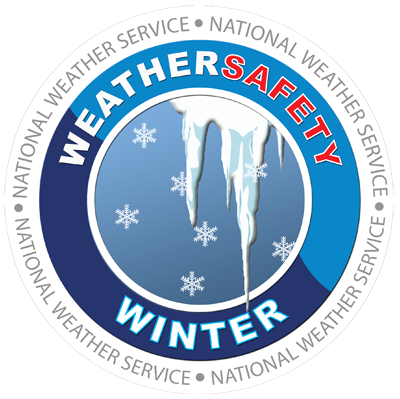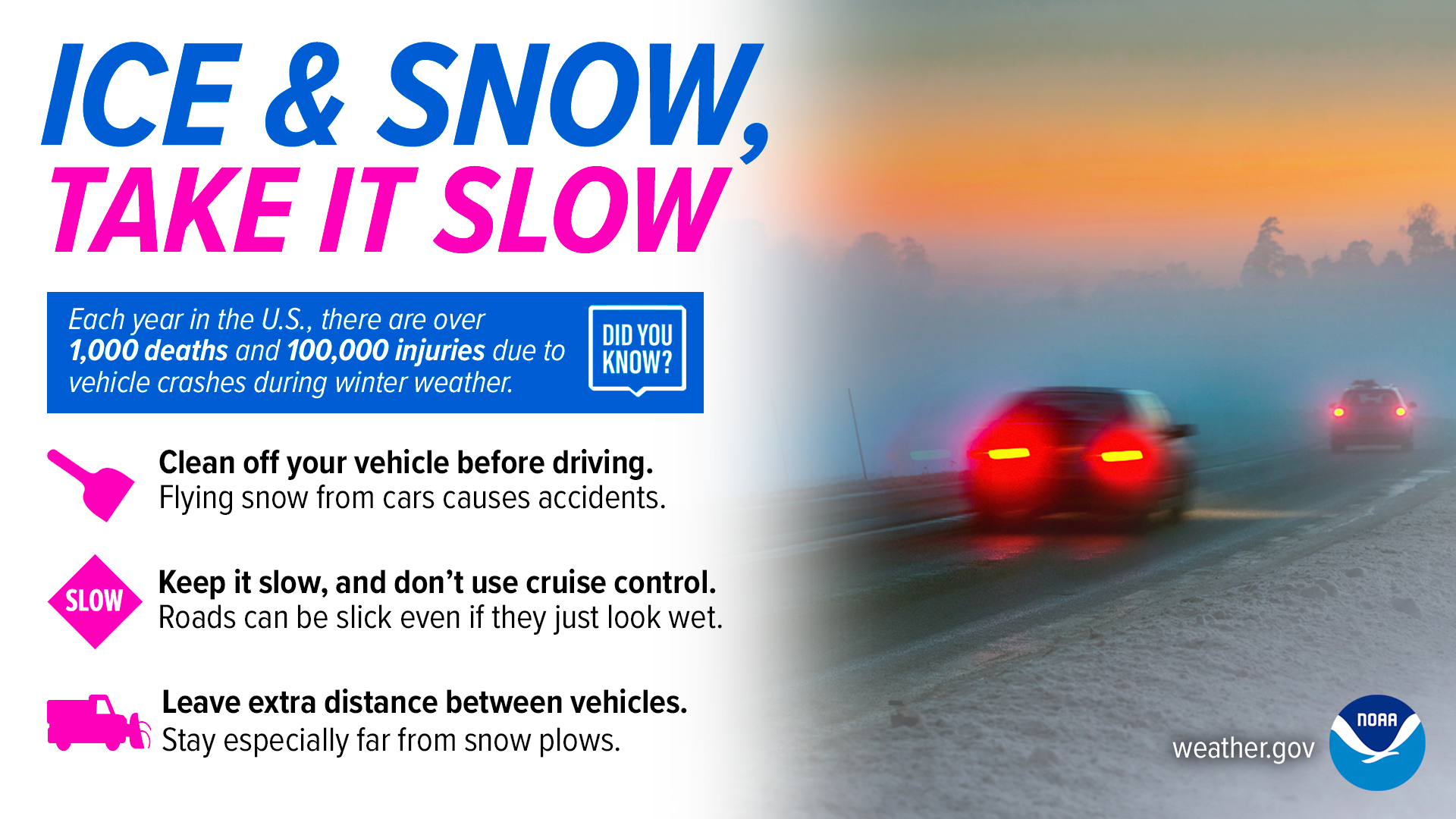
High winds and very dry conditions will continue to produce elevated to critical fire weather conditions over portions of New Mexico and far western Texas through Saturday. Heavy snow will continue in the Central Rockies Heavy rain, flooding, and severe thunderstorm risks increase from the Southern Plains into the Lower Missouri Valley this weekend. Read More >
 |
Kansas Winter Weather Awareness Page
|
Wintertime poses a wide range of threats to the American public. Whether it be vehicle accidents caused by slick roads, exposure to the cold, or fires resulting from the improper use of heaters, hundreds of people are injured or killed each year as a direct result of winter weather. Kansas is no exception!
 Winter storms can range from a moderate snow or freezing rain over a few hours to a massive blizzard with blinding, wind-driven snow that lasts for several days. Some winter storms are large enough to affect several states while others affect only a single community. Conditions can change in an instant!
Winter storms can range from a moderate snow or freezing rain over a few hours to a massive blizzard with blinding, wind-driven snow that lasts for several days. Some winter storms are large enough to affect several states while others affect only a single community. Conditions can change in an instant!
High winds, freezing rain or sleet, heavy snowfall, and dangerously cold temperatures are the main hazards associated with winter storms. Damage from ice storms or snowstorms can maroon people at home without utilities or other services for days after an event. Slick roads from ice or snow buildup can result in large numbers of vehicle accidents. Severely cold temperatures and wind chills during and after a winter storm can lead to hypothermia and kill anyone caught outside for too long. The aftermath of a winter storm can impact a community or region for days, weeks, or even months, incurring steep economic costs.
Terms to Know:
The chart below shows how the different types of winter precipitation are formed.

How the National Weather Service Keeps You Informed
The National Weather Service issues four "tiers" of alerts to inform you of incoming hazardous weather. Please take a moment to review and understand the differences between them.
Outlook:
Watch:
Advisory:
Warning:
Below is a break down the different alerts issued by the National Weather Service in Topeka
* Deviations from these criteria may be made on a case-by-case based on the expected level of impacts from the winter weather event.
Wind Chill
The wind chill temperature is not the actual air temperature, but a “feels like” temperature when one factors in temperatures AND wind speeds. Increasing winds will accelerate the amount of heat lost by the body via exposed skin, driving down the body temperature. Animals are also affected by wind chill.
The only effect wind chill has on inanimate objects, such as car radiators and water pipes, is to shorten the amount of time it takes for the object to cool. An inanimate object will not cool below the actual air temperature. For example, if the temperature outside is -5°F and the wind chill temperature is -31°F, then your car's radiator will not drop lower than -5°F.
The wind chill chart below was developed based on joint U.S.-Canadian research. The chart includes a frostbite indicator, showing the points where temperature, wind speed and exposure time will produce frostbite on humans. Each shaded area shows how long a person can be exposed before frostbite develops.
Note: Wind chill temperature is only defined for temperatures at or below 50°F and wind speeds above 3 mph. Bright sunshine may increase the wind chill temperature by 10 to 18°F.
Frostbite and Hypothermia
Unusually cold temperatures are especially dangerous in areas not accustomed to them because residents are generally unprepared and may not realize the danger severe cold presents. Always remember to wear light, dry, loose fitting layers, mittens or gloves (mittens are warmer than gloves) and a hat to prevent the loss of body heat. Cover your mouth to protect your lungs from frigid air. Exposure to the cold can cause frostbite and life-threatening hypothermia.
**Always seek immediate medical treatment for both frostbite and hypothermia**
| Symptoms | First Aid | |
|---|---|---|
| Frostbite | Loss of feeling in the affected area and skin that appears waxy, is cold to the touch or is discolored (flushed, white, grey, yellow or blue). | Handle the affected area gently and do not rub it. Warm gently by soaking the affected area in warm (not hot) water until it appears red and feels warm. Loosely bandage the area with dry, sterile dressings. If the person’s fingers or toes are frostbitten, place dry, sterile gauze between them to keep them separated. Avoid breaking any blisters and do not allow the affected area to refreeze. |
| Hypothermia | Uncontrollable shivering, numbness, glassy stare, incoherence, slurred speech, weakness, or loss of consciousness. | Gently move the person to a warm place. Give rescue breathing and CPR as needed. Remove any wet clothing and dry the person. Warm the person slowly by wrapping him or her in blankets or putting on warm clothing. Hot water bottles or hot packs may be used to help warm, but must be wrapped in a towel or blanket before applying. Warm the core first (trunk, abdomen), not the extremities (hands, feet). Warming extremities first could cause shock, or drive cold blood towards the heart, causing heart failure. Do not warm the person too quickly, such as immersing him or her in warm water, as this could lead to dangerous heart arrhythmias. |
Safety on the Road
Driving safely in dangerous winter weather means not only taking the appropriate steps during the storm, but also having the right supplies beforehand. If you wait to stock up on supplies until a watch or warning is issued, you run the risk of the supplies being unavailable.

 Fall is an excellent opportunity to check the winter supplies in your vehicle and stock up on anything that is running low.
Fall is an excellent opportunity to check the winter supplies in your vehicle and stock up on anything that is running low.
Each fall, take the time to go through your vehicle and winterize it. Use the list below as guidance (click the image for a printable version).
Most Importantly!

Make sure you carry a winter survival kit in your car in case you get stranded. You can use a large plastic tote or box to hold all of the needed items. If you already have one in your car, go through it and make sure it is fully stocked and ensure that any perishable items are still good to use. Items that should be in a winter survival kit are covered in the checklist below (click for printable version).
 If you must drive during or immediately after a winter storm...
If you must drive during or immediately after a winter storm...
 If you become stranded in your vehicle...
If you become stranded in your vehicle...
Heading Outside
Below are some tips for staying warm if you must venture outside in a winter storm or cold weather.
 Wear several layers of loose-fitting, lightweight, warm clothing (shirts, pants, socks, etc.) rather than
Wear several layers of loose-fitting, lightweight, warm clothing (shirts, pants, socks, etc.) rather thanPlanning an Outdoor Trip?
If you are planning to take a hunting, camping, or other extended outdoor trip in the mid fall to mid spring timeframe, pay attention to the weather in the days leading up to the trip. If severe winter weather is forecast, consider postponing the trip. If you do head out:
 Should you become caught outside in a violent winter storm...
Should you become caught outside in a violent winter storm...
Safety in your Home
Being safe at home in dangerous winter weather means not only taking the appropriate steps during the storm, but also having the right supplies beforehand. If you wait to stock up on supplies until a watch or warning is issued, you run the risk of the supplies being out of stock or the store being closed.

 Fall is an excellent opportunity to check the winter supplies in your home and stock up on anything that is running low.
Fall is an excellent opportunity to check the winter supplies in your home and stock up on anything that is running low.
The checklist below provides some basic guidance on what to have in your house/apartment during the winter should you be trapped by the snow or lose electricity. This is not an exhaustive list (click for printable version).
Food and water are vital necessities during a winter storm; however, these foods should be safe to consume should power be lost. Use the checklist below to help stock your shelves (click for printable version).
During severe winter weather, the best advice is to stay inside your house! Plummeting temperatures and high winds that often accompany winter storms allow frostbite and hypothermia to set in quickly if you are outside. Also, road conditions will likely be very treacherous, especially if you live in rural areas. Monitor local media outlets for the latest information on the storm.